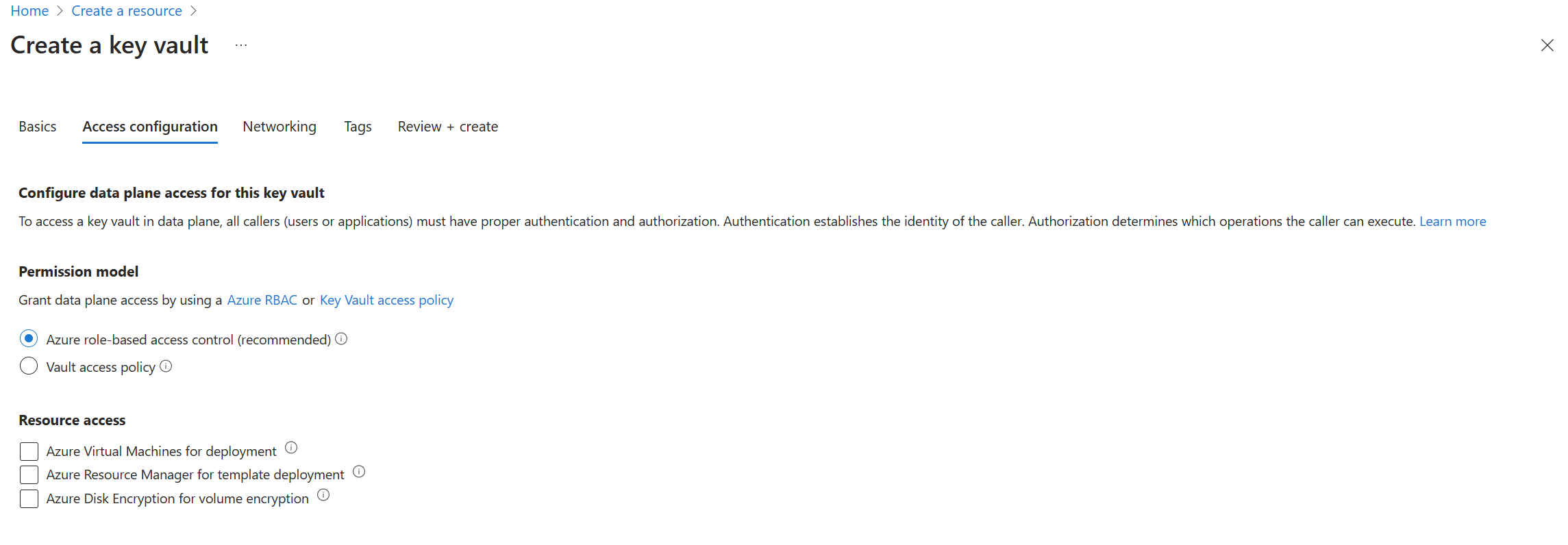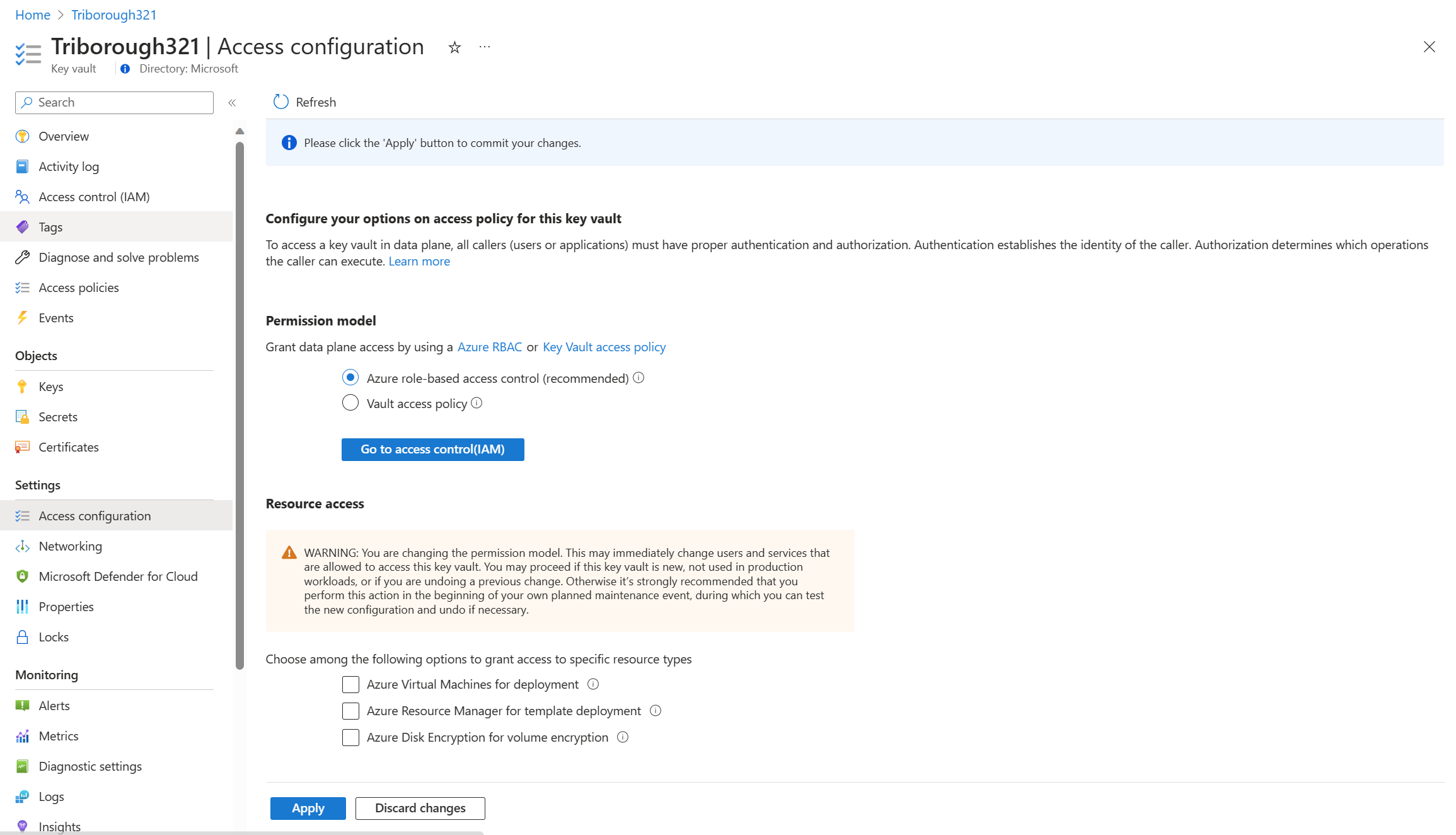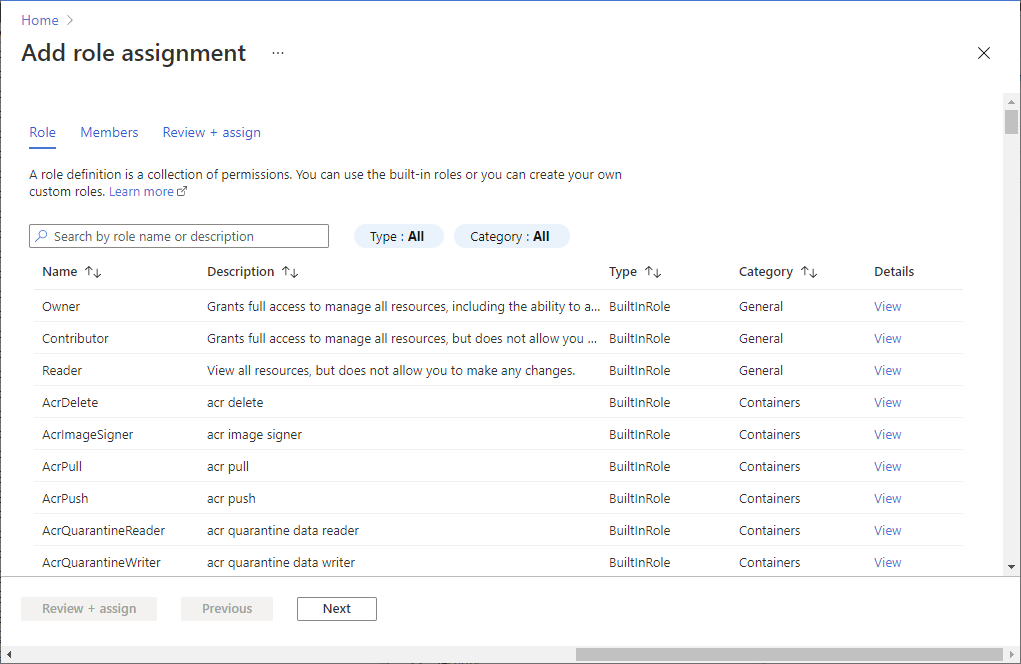Provide access to Key Vault keys, certificates, and secrets with an Azure role-based access control
Note
Key Vault resource provider supports two resource types: vaults and managed HSMs. Access control described in this article only applies to vaults. To learn more about access control for managed HSM, see Managed HSM access control.
Note
Azure App Service certificate configuration through Azure Portal does not support Key Vault RBAC permission model. You can use Azure PowerShell, Azure CLI, ARM template deployments with Key Vault Certificate User role assignment for App Service global identity, for example Microsoft Azure App Service' in public cloud.
Azure role-based access control (Azure RBAC) is an authorization system built on Azure Resource Manager that provides centralized access management of Azure resources.
Azure RBAC allows users to manage keys, secrets, and certificates permissions, and provides one place to manage all permissions across all key vaults.
The Azure RBAC model allows users to set permissions on different scope levels: management group, subscription, resource group, or individual resources. Azure RBAC for key vault also allows users to have separate permissions on individual keys, secrets, and certificates.
For more information, see Azure role-based access control (Azure RBAC).
Best Practices for individual keys, secrets, and certificates role assignments
Our recommendation is to use a vault per application per environment (Development, Pre-Production, and Production) with roles assigned at the key vault scope.
Assigning roles on individual keys, secrets and certificates should be avoided. An exception is a scenario where individual secrets must be shared between multiple applications; for example, where one application needs to access data from another application.
More about Azure Key Vault management guidelines, see:
Azure built-in roles for Key Vault data plane operations
Note
The Key Vault Contributor role is for management plane operations only to manage key vaults. It does not allow access to keys, secrets and certificates.
| Built-in role | Description | ID |
|---|---|---|
| Key Vault Administrator | Perform all data plane operations on a key vault and all objects in it, including certificates, keys, and secrets. Cannot manage key vault resources or manage role assignments. Only works for key vaults that use the 'Azure role-based access control' permission model. | 00482a5a-887f-4fb3-b363-3b7fe8e74483 |
| Key Vault Reader | Read metadata of key vaults and its certificates, keys, and secrets. Cannot read sensitive values such as secret contents or key material. Only works for key vaults that use the 'Azure role-based access control' permission model. | 21090545-7ca7-4776-b22c-e363652d74d2 |
| Key Vault Purge Operator | Allows permanent deletion of soft-deleted vaults. | a68e7c17-0ab2-4c09-9a58-125dae29748c |
| Key Vault Certificates Officer | Perform any action on the certificates of a key vault, excluding reading the secret and key portions, and managing permissions. Only works for key vaults that use the 'Azure role-based access control' permission model. | a4417e6f-fecd-4de8-b567-7b0420556985 |
| Key Vault Certificate User | Read entire certificate contents including secret and key portion. Only works for key vaults that use the 'Azure role-based access control' permission model. | db79e9a7-68ee-4b58-9aeb-b90e7c24fcba |
| Key Vault Crypto Officer | Perform any action on the keys of a key vault, except manage permissions. Only works for key vaults that use the 'Azure role-based access control' permission model. | 14b46e9e-c2b7-41b4-b07b-48a6ebf60603 |
| Key Vault Crypto Service Encryption User | Read metadata of keys and perform wrap/unwrap operations. Only works for key vaults that use the 'Azure role-based access control' permission model. | e147488a-f6f5-4113-8e2d-b22465e65bf6 |
| Key Vault Crypto User | Perform cryptographic operations using keys. Only works for key vaults that use the 'Azure role-based access control' permission model. | 12338af0-0e69-4776-bea7-57ae8d297424 |
| Key Vault Crypto Service Release User | Release keys for Azure Confidential Computing and equivalent environments. Only works for key vaults that use the 'Azure role-based access control' permission model. | |
| Key Vault Secrets Officer | Perform any action on the secrets of a key vault, except manage permissions. Only works for key vaults that use the 'Azure role-based access control' permission model. | b86a8fe4-44ce-4948-aee5-eccb2c155cd7 |
| Key Vault Secrets User | Read secret contents including secret portion of a certificate with private key. Only works for key vaults that use the 'Azure role-based access control' permission model. | 4633458b-17de-408a-b874-0445c86b69e6 |
For more information about Azure built-in roles definitions, see Azure built-in roles.
Managing built-in Key Vault data plane role assignments
| Built-in role | Description | ID |
|---|---|---|
| Key Vault Data Access Administrator | Manage access to Azure Key Vault by adding or removing role assignments for the Key Vault Administrator, Key Vault Certificates Officer, Key Vault Crypto Officer, Key Vault Crypto Service Encryption User, Key Vault Crypto User, Key Vault Reader, Key Vault Secrets Officer, or Key Vault Secrets User roles. Includes an ABAC condition to constrain role assignments. | 8b54135c-b56d-4d72-a534-26097cfdc8d8 |
Using Azure RBAC secret, key, and certificate permissions with Key Vault
The new Azure RBAC permission model for key vault provides alternative to the vault access policy permissions model.
Prerequisites
You must have an Azure subscription. If you don't, you can create a free account before you begin.
To manage role assignments, you must have Microsoft.Authorization/roleAssignments/write and Microsoft.Authorization/roleAssignments/delete permissions, such as Key Vault Data Access Administrator (with restricted permissions to only assign/remove specific Key Vault roles), User Access Administrator, or Owner.
Enable Azure RBAC permissions on Key Vault
Note
Changing the permission model requires unrestricted 'Microsoft.Authorization/roleAssignments/write' permission, which is part of the Owner and User Access Administrator roles. Classic subscription administrator roles like 'Service Administrator' and 'Co-Administrator', or restricted 'Key Vault Data Access Administrator' cannot be used to change permission model.
Enable Azure RBAC permissions on new key vault:

Enable Azure RBAC permissions on existing key vault:

Important
Setting Azure RBAC permission model invalidates all access policies permissions. It can cause outages when equivalent Azure roles aren't assigned.
Assign role
Note
It's recommended to use the unique role ID instead of the role name in scripts. Therefore, if a role is renamed, your scripts would continue to work. In this document role name is used for readability.
To create a role assignment using the Azure CLI, use the az role assignment command:
az role assignment create --role {role-name-or-id} --assignee {assignee-upn}> --scope {scope}
For full details, see Assign Azure roles using Azure CLI.
Resource group scope role assignment
az role assignment create --role "Key Vault Reader" --assignee {i.e user@microsoft.com} --scope /subscriptions/{subscriptionid}/resourcegroups/{resource-group-name}
For full details, see Assign Azure roles using Azure CLI.
Above role assignment provides ability to list key vault objects in key vault.
Key Vault scope role assignment
az role assignment create --role "Key Vault Secrets Officer" --assignee {assignee-upn} --scope /subscriptions/{subscriptionid}/resourcegroups/{resource-group-name}/providers/Microsoft.KeyVault/vaults/{key-vault-name}
For full details, see Assign Azure roles using Azure CLI.
Secret scope role assignment
Note
Key vault secret, certificate, key scope role assignments should only be used for limited scenarios described here to comply with security best practices.
az role assignment create --role "Key Vault Secrets Officer" --assignee {i.e user@microsoft.com} --scope /subscriptions/{subscriptionid}/resourcegroups/{resource-group-name}/providers/Microsoft.KeyVault/vaults/{key-vault-name}/secrets/RBACSecret
For full details, see Assign Azure roles using Azure CLI.
Test and verify
Note
Browsers use caching and page refresh is required after removing role assignments. Allow several minutes for role assignments to refresh
Validate adding new secret without "Key Vault Secrets Officer" role on key vault level.
Go to key vault Access control (IAM) tab and remove "Key Vault Secrets Officer" role assignment for this resource.

Navigate to previously created secret. You can see all secret properties.

Create new secret ( Secrets > +Generate/Import) should show this error:

Validate secret editing without "Key Vault Secret Officer" role on secret level.
Go to previously created secret Access Control (IAM) tab and remove "Key Vault Secrets Officer" role assignment for this resource.
Navigate to previously created secret. You can see secret properties.

Validate secrets read without reader role on key vault level.
Go to key vault resource group Access control (IAM) tab and remove "Key Vault Reader" role assignment.
Navigating to key vault's Secrets tab should show this error:

Creating custom roles
az role definition create command
az role definition create --role-definition '{ \
"Name": "Backup Keys Operator", \
"Description": "Perform key backup/restore operations", \
"Actions": [
], \
"DataActions": [ \
"Microsoft.KeyVault/vaults/keys/read ", \
"Microsoft.KeyVault/vaults/keys/backup/action", \
"Microsoft.KeyVault/vaults/keys/restore/action" \
], \
"NotDataActions": [
], \
"AssignableScopes": ["/subscriptions/{subscriptionId}"] \
}'
For more Information about how to create custom roles, see:
Frequently Asked Questions
Can I use Key Vault role-based access control (RBAC) permission model object-scope assignments to provide isolation for application teams within Key Vault?
No. RBAC permission model allows you to assign access to individual objects in Key Vault to user or application, but any administrative operations like network access control, monitoring, and objects management require vault level permissions, which will then expose secure information to operators across application teams.


